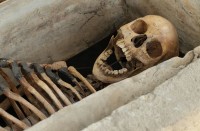 The skeleton of a Roman woman that inspired one of Sylvia Plath’s most memorable poems is back on display after 30 years in storage.
The skeleton of a Roman woman that inspired one of Sylvia Plath’s most memorable poems is back on display after 30 years in storage.
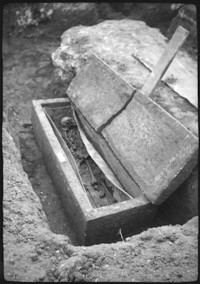 The skeleton of a wealthy woman from the 4th century A.D. was one of a number of high-status Roman burials found by construction workers clearing land in Arbury, just outside of Cambridge, in 1952. She had been wrapped in a woolen shroud and laid to rest in a massive stone and lead-lined coffin, but despite her expensive accommodations, the undertakers made two notable mistakes: they put her in the wrong way around, and they either didn’t put the lid on flush or they let a mouse and a shrew move in before covering the coffin. When the coffin was opened in 1952, the skeletons of the mouse and shrew were found inside and the 40 to 55-year-old woman’s ankle showed signs of having been gnawed by her companions.
The skeleton of a wealthy woman from the 4th century A.D. was one of a number of high-status Roman burials found by construction workers clearing land in Arbury, just outside of Cambridge, in 1952. She had been wrapped in a woolen shroud and laid to rest in a massive stone and lead-lined coffin, but despite her expensive accommodations, the undertakers made two notable mistakes: they put her in the wrong way around, and they either didn’t put the lid on flush or they let a mouse and a shrew move in before covering the coffin. When the coffin was opened in 1952, the skeletons of the mouse and shrew were found inside and the 40 to 55-year-old woman’s ankle showed signs of having been gnawed by her companions.
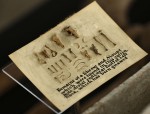 The coffin and skeletons were put on display in the Clark Gallery of Cambridge University’s Museum of Archaeology and Anthropology. Cambridge researchers arranged the bones of the mouse and shrew on a placard and displayed them along with the coffin. Sylvia Plath attended Newnham College, Cambridge, on a Fulbright scholarship between 1955 and 1957. The gnawed-upon woman and her rodent friends at the museum inspired her to write All the Dead Dears.
The coffin and skeletons were put on display in the Clark Gallery of Cambridge University’s Museum of Archaeology and Anthropology. Cambridge researchers arranged the bones of the mouse and shrew on a placard and displayed them along with the coffin. Sylvia Plath attended Newnham College, Cambridge, on a Fulbright scholarship between 1955 and 1957. The gnawed-upon woman and her rodent friends at the museum inspired her to write All the Dead Dears.
Rigged poker-stiff on her back
With a granite grin
This antique museum-cased lady
Lies, companioned by the gimcrack
Relics of a mouse and a shrew
That battened for a day on her ankle-bone.These three, unmasked now, bear
Dry witness
To the gross eating game
We’d wink at if we didn’t hear
Stars grinding, crumb by crumb,
Our own grist down to its bony face.
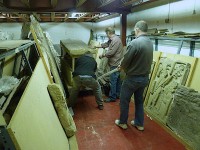 The Dead Dears remained on display from the 1950s until the 1980s when they were moved to storage because of overcrowding. Now that the museum has completed a major 18-month, $2.8 million dollar refurbishment, many important pieces that have never been on public display and some important pieces that have been out of public view for decades have returned, including the gnawed-upon Roman woman and the original shrew and mouse placard which so impressed Sylvia Plath.
The Dead Dears remained on display from the 1950s until the 1980s when they were moved to storage because of overcrowding. Now that the museum has completed a major 18-month, $2.8 million dollar refurbishment, many important pieces that have never been on public display and some important pieces that have been out of public view for decades have returned, including the gnawed-upon Roman woman and the original shrew and mouse placard which so impressed Sylvia Plath.
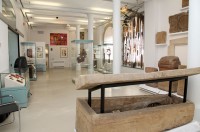 Cambridge has a huge collection of artifacts from around the world donated by wealthy alumni and scholars, as well as local discoveries that illustrate the ancient Roman and Anglo-Saxon history of the Cambridge area, all the way through to the founding of the university and beyond. The new gallery will have almost double the number of objects on display, but even so that is less than 1% of the museum’s entire collection.
Cambridge has a huge collection of artifacts from around the world donated by wealthy alumni and scholars, as well as local discoveries that illustrate the ancient Roman and Anglo-Saxon history of the Cambridge area, all the way through to the founding of the university and beyond. The new gallery will have almost double the number of objects on display, but even so that is less than 1% of the museum’s entire collection.
The refurbished gallery reopens on May 25th. See the museum’s Facebook page for tons of pictures and updates documenting the refurbishment. Here’s a lovely video about the refurbishment and the collection. Watch it full screen because there are some beautiful shots of the artifacts, including a 45-foot-tall totem pole from British Columbia, the Arbury skeleton and a Roman vase decorated with naked ladies and a proliferation of phalluses. It was discovered in Great Chesterford, Essex in the 19th century and so scandalized the Victorians who found it that they never recorded it as one of the finds from the site.
[youtube=http://www.youtube.com/watch?v=6r4LwuoFPoY&w=430]